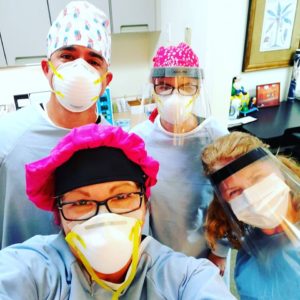Reopening an Endodontic Practice: A Q&A with AAE Member Dr. Matthew Chesler
The AAE recently spoke with Dr. Matthew Chesler of San Diego North Endodontics to learn more about operating an endodontic practice safely and effectively as states and communities across the country reopen.

From: San Diego North Endodontics
Facebook Page
“Here we go!” — with Matthew Chesler, Carmen Leon and Melody Bassett Seekins.
Can you tell us about the steps you’ve taken to protect yourself, your patients and staff?
It starts with the first contact over the phone where a set of screening questions are asked. Provided a patient responds in the negative to these questions, the appointment is made. When the patient arrives for their scheduled appointment, they are instructed to call us upon arrival. They are then given permission to enter the office, with a mask on. This way, we control the amount of people in the office at any given time. At this point, we have a table with hand sanitizer that is to be used upon entry. They will then approach the reception desk where the patient’s temperature is taken with a contactless thermometer. The screening questions are repeated at this time as well. Walk-ins are discouraged at this time. We have also obtained two air purifying units from Surgically Clean Air as well as two UV-C lights for end of day disinfection for each operatory.
What sort of PPE do you use? Do you provide anything for the patients to limit their exposure too?
We currently have two types of N95 masks, in addition to level 3 surgical masks. The N95’s are worn during treatment appointments and the level 3’s during consultations and follow-ups. We’ve also added full head covers and gowns, both of which are reusable and are used for a single patient and then laundered. My assistants use full face shields as well. Patients are instructed to leave their personal masks on until treatment is started and to replaced them once treatment is completed.
Can you tell us about your efforts to reduce staff or patient anxiety?
The most important conversation I have had was with my staff. I told them that until they feel comfortable, we would not open. Despite shortages, we were able to acquire enough of the appropriate PPE to protect all those involved. We review procedures on a daily basis to see where processes can be improved. Since this is an entirely new scenario, it’s a constant work in progress. As for patients, there’s an inherent anxiety for most people coming in for endodontic therapy. Although CDC instructions recommend entering the room in full PPE, I take a brief moment before I step into the operatory to introduce myself so the patient can see a face that isn’t completely covered in PPE. At that point, I’ll get into my PPE, enter the room and begin the pre-op consultation.
Can you tell us about the ways you and your staff have promoted your practice and/or increased awareness that you’re open for treatments?
I have a staff member who is a social media expert. She has kept our followers in the loop from the time the lock-downs started. We’ve also had numerous posts since we’ve been back showing everyone how things are different, but safe, during this period. I have reached out to our referring doctors to let them know we’re back as well.
What advice do you have for your fellow endodontists who plan to resume normal business hours?
Make sure you take the time to establish a plan. The ADA put out a very useful “Return to Work” toolkit that encompasses all aspects of running a practice. Make sure you have the right kind of PPE, and enough of it, to keep everyone safe. We’ve extended our appointment times so that there’s less crossover between patients coming in and out. We now see fewer patients than we did before, but that seems to be the case with our referrals as well. Know that the situation is fluid and check in with your staff often. Process improvement should be constantly employed to create the best environment for all those involved.
Similarly, what advice would you like to give to your fellow endodontists who may not be open normal business hours or seeing patients only during emergencies?
Only proceed forward when you feel comfortable doing so. Feeling uncomfortable or ill-prepared will have an effect not only on you & your staff, but in the quality of treatment that is provided to your patients. Don’t think of it as a light switch that is either “on” or “off”, but rather a dimmer switch that can be increased with time.
Have you utilized any COVID-19 relief packages passed by state or federal officials? If so, can you tell me about the process? How have the funds helped you?
We utilized both the PPP and the EIDL. The PPP was vitally important in getting back to work quickly by infusing needed cash into the practice, especially for payroll. Recently, the rules have changed and the time frame for usage of these funds has been extended to 24 weeks from 8 weeks, which is helpful.
Is there anything else you’d like endodontists and patients to know?
It’s been said before, but we’re all in this together. It’s not limited to any single city or state. Establishing a plan for safety, and continual monitoring and adjustment of that plan, will help to ensure a transition back to full-time practice. Remember also to move at your own pace. If something feels uncomfortable, or you feel like you’re missing steps, stop. For patients, know that we are doing everything we can to make you feel safe and comfortable, while still providing the highest level of endodontic care possible. It’s a lot to juggle at any one time and we appreciate you working with us as we manage the way we deliver care in this new era.




